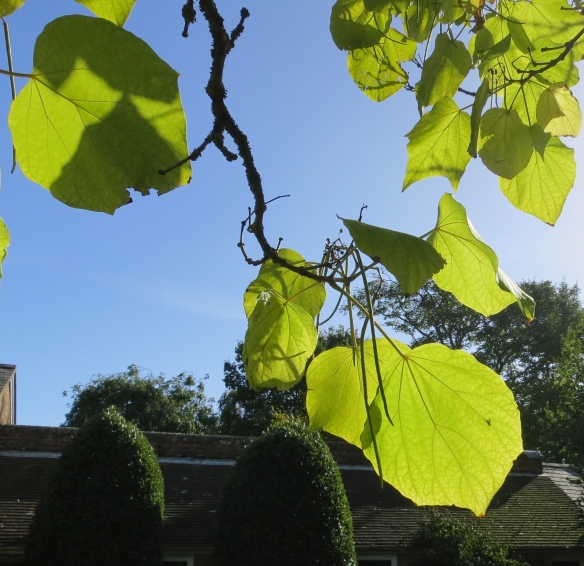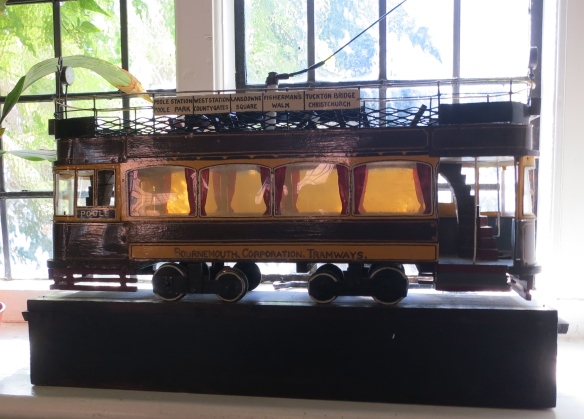We enjoyed another beautifully balmy Indian summer day for our trip to Christchurch’s Red House Museum.
Operated by volunteers there are sections devoted to learning about The Victorians and the twentieth century; and archeological finds going back to neolithic times. A small garden is as informative as the rooms inside. In particular we are told the benefits provided by various plants to the ecology. There is a plentifully stocked herb garden and another for roses.
The teenage tyrant Noah Claypole, in Charles Dickens’s ‘Oliver Twist’, named the eponymous hero ‘Work’us’, because the boy had spent his first nine years in a workhouse. Oliver would no doubt have recognised this 1764 Georgian building in its original incarnation, for it was built as a workhouse: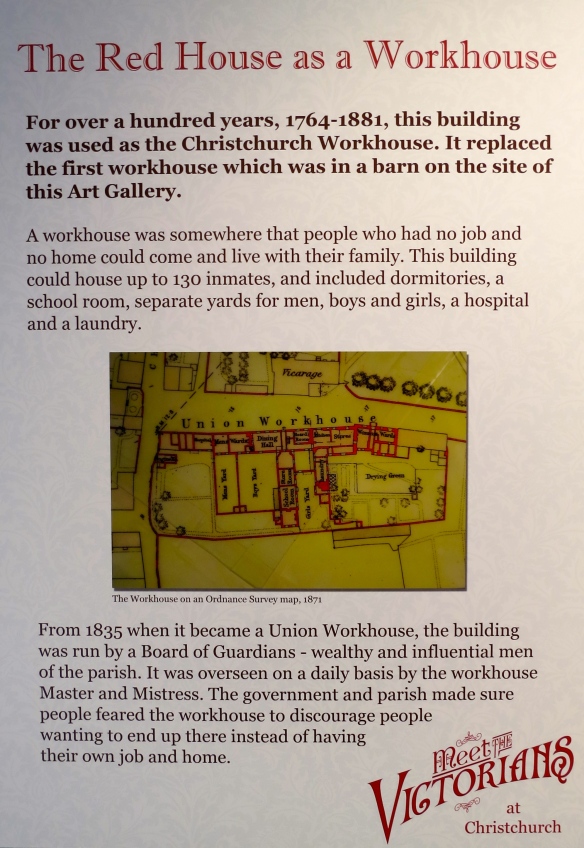
The separate women’s section of this building is no longer in existence. The rose garden is planted where it stood. 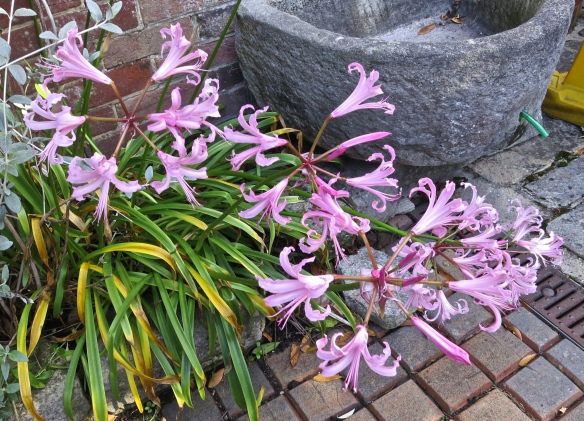 Some of the roses were still in bloom this afternoon, as were a fine crop of nerines.
Some of the roses were still in bloom this afternoon, as were a fine crop of nerines.
A fly basked on a catalpa leaf. 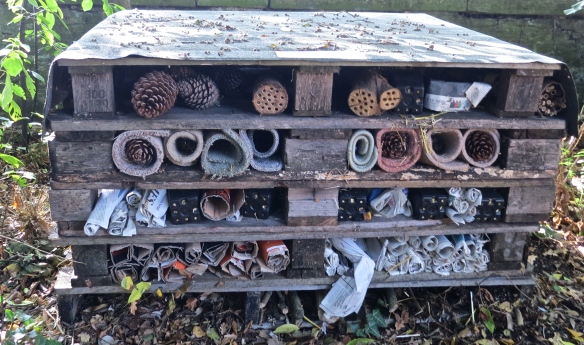 Perhaps it had just checked out of the bug hotel in the woodland walk..
Perhaps it had just checked out of the bug hotel in the woodland walk..
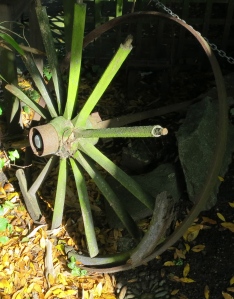 Elsewhere in the garden one or two cartwheels that have seen better days are distributed for rustic effect.
Elsewhere in the garden one or two cartwheels that have seen better days are distributed for rustic effect.
As one wanders from room to room of this imaginatively laid out, not terribly extensive, town garden, various glimpses of the Priory Church can be had through the sometimes decorative foliage.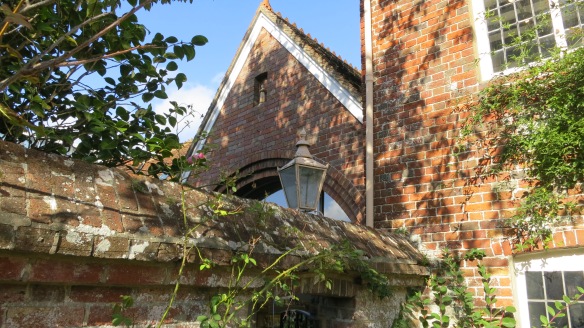
A small figure of St Francis of Assisi stands in a niche in the rear entrance archway.
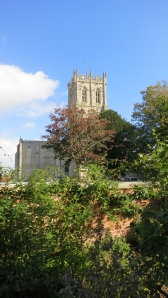
Once inside, we were warmly welcomed; informed, as I took out my wallet, that the tour was free; and given a brief explanation of the layout. Donations were invited, but not until we had been satisfied.
The Meet the Victorians exhibition uses modern materials and artwork to take us through different aspects of the life of that era. Original objects are on display with a timeline of a typical workhouse day.
Arthur Romney Green was a local craftsman making furniture in the 1930s.  The 1935 room contains model figures with real pieces of his work in a setting typical of the time. I imagine this family were better off than many. Note the Clarice Cliff tea set.
The 1935 room contains model figures with real pieces of his work in a setting typical of the time. I imagine this family were better off than many. Note the Clarice Cliff tea set.
One can only make a selection of the artefacts and other items on display. I have chosen one or two that have some meaning for me.
Being confronted by the huge box mangle I experienced a sense of relief that it hadn’t been in our mother’s kitchen when I experimented on Chris’s finger. When we were very young Mum had no washing machine, and so washed everything by hand. She did, however, have a wooden mangle. Sheets, in particular, were placed between two rollers, and you turned a handle in order to squeeze and therefore rinse them. One day Chris left his finger in as I turned the handle. Fortunately his bones must have been still soft enough to be re-inflated. The museum exhibit looked a bit more heavy duty than our version.
The model tram on a window sill reminded me of those I travelled on as a child down Wimbledon Broadway. After trams and trolleybuses, it was the 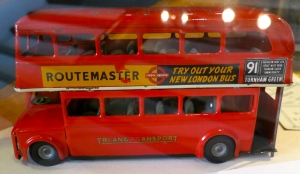 Routemaster, a model of one of which lay in a cabinet, that became London Transport’s bus of choice from 1954 until the last one was taken out of service in 2005. In our more safety-conscious age, it is no longer considered appropriate to have an open doorway, from which the tardy or the daring can jump on or off a public service vehicle. I discovered that you can still hire out a Routemaster for special events on 31st August, when Anne’s car was blocked in by a pair of them that had been hired for a wedding party.
Routemaster, a model of one of which lay in a cabinet, that became London Transport’s bus of choice from 1954 until the last one was taken out of service in 2005. In our more safety-conscious age, it is no longer considered appropriate to have an open doorway, from which the tardy or the daring can jump on or off a public service vehicle. I discovered that you can still hire out a Routemaster for special events on 31st August, when Anne’s car was blocked in by a pair of them that had been hired for a wedding party.
It is probably well known that one task given to adult workhouse residents was the very painful one of picking oakum. 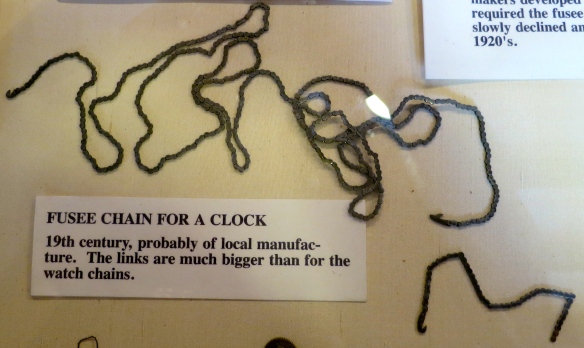 Much smaller, more flexible, fingers were needed to make fusee chains for clocks and watches. Young girls had that job. Most of them consequently suffered from damaged eyesight.
Much smaller, more flexible, fingers were needed to make fusee chains for clocks and watches. Young girls had that job. Most of them consequently suffered from damaged eyesight.
A neighbouring case to the one that held the chain contained early writing implements.  The steel-nibbed pens reminded me of those with which I had learned to write at primary school. Desks had notches for ink wells into which we dipped our pens. One summer I injured my right hand. I don’t remember how, but I most certainly do remember being made to write with my left hand until the other one recovered. I am of course not alone in having, during that era, had to go through that particular form of educational torture. Nor of the others mentioned on 1st November last year, when I attempted to entertain with tales of my primary school years.
The steel-nibbed pens reminded me of those with which I had learned to write at primary school. Desks had notches for ink wells into which we dipped our pens. One summer I injured my right hand. I don’t remember how, but I most certainly do remember being made to write with my left hand until the other one recovered. I am of course not alone in having, during that era, had to go through that particular form of educational torture. Nor of the others mentioned on 1st November last year, when I attempted to entertain with tales of my primary school years.
The Southwell Workhouse museum is in stark contrast to the one we visited today. Opened by the National Trust earlier this century, it is the most complete workhouse in existence. The buildings and exercise yards are intact and, with one exception, completely bare and unfurnished. Visitors are given a dramatised audio commentary with which to absorb the ambience of the housing of the poor in times gone by. It is very effective. The exception is the floor that was used as a women’s refuge in the 1970s. That is furnished as it was then with objects that had been provided by various charities, and largely consisted of other people’s cast offs. I well remember an identical kitchen cabinet with a drop-down shelf to that that had been my mother’s pride and joy in the 1950s.
The rows of cast iron single bedsteads were rather depressing, especially when reflecting on why the residents lived there.
Fish and chips, mushy peas, and Stelle d’Italia Prosecco provided our evening sustenance.
